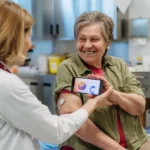Cellular Devices Driving Remote Patient Monitoring (RPM) Success

In recent years, Remote Patient Monitoring (RPM) has become an increasingly adopted technology for healthcare providers to track and manage their patients’ health remotely. This technology allows patients to send their vital signs and other health metrics at home using various devices, which then transmit the data to their healthcare providers in real-time.
One of the key drivers of success in RPM programs is the use of cellular medical devices, which offer numerous advantages over Bluetooth monitoring devices.
Table of Contents
ToggleCellular Devices Are Easy To Use
Ease of patient use is a critical factor in the success of any RPM program. Cellular devices are typically very user-friendly, with simple interfaces that make it easy for patients to take and transmit their readings. This ease of use encourages patients to regularly monitor their health metrics, leading to more accurate and timely data for healthcare providers.
In contrast, other types of monitoring devices, such as Bluetooth devices, can be more complex and unreliable, leading to frustration for patients and potentially inaccurate data for providers.
Disadvantages of Bluetooth Monitoring Devices
One of the disadvantages of Bluetooth devices is that they rely on a stable Bluetooth connection to transmit data, which can be challenging in certain situations. For example, if a patient’s phone is out of range of the device, or if there is interference from other Bluetooth devices in the area, the connection may be lost, leading to missing or delayed data.
- Bluetooth connections can occasionally be “discovered,” which means that transmitting health data over the short-range wireless connection may raise security concerns.
- Bluetooth can be complex to configure, and connections may need to be established multiple times if a device has to be updated.
- Bluetooth pairing troubles between devices and phones can annoy patients and contribute to an increase in need for technical support.
- To transmit their health data to their healthcare team, patients must have access to the internet.
Cellular devices, on the other hand, are network independent and connect to the strongest network available, ensuring a more reliable and consistent connection for data transmission.
Cellular Devices Offer Better Connectivity Options
In terms of connectivity options, cellular devices offer more flexibility than Bluetooth devices. Cellular devices can even store readings offline and transmit them to the healthcare provider’s RPM portal when a connection is available, ensuring that no data is lost even in areas with poor or no cellular coverage. This feature is especially important for patients in rural or remote areas who may not always have access to a stable internet connection.
Cellular Devices Are Highly Reliable
Another key advantage of cellular devices is their reliability. Since cellular devices are consistently connected to the network, data is transmitted directly to the software portal without the need for manual intervention from the patient.
This direct transmission reduces the risk of errors or delays in data transmission, ensuring that healthcare providers have access to real-time, accurate data on their patients’ health to make timely and informed decisions about patient care, especially in cases where timely intervention is needed.
Frequently Asked Questions (FAQs)
Cellular devices are medical monitoring tools that send patient health data, like vital signs, directly and reliably to healthcare providers using built-in cell network connectivity instead of Bluetooth or WiFi.
They make things easier for users: cellular devices send data automatically, so you don’t have to worry about pairing with a phone, Bluetooth range, or connection drops, or deal with frequent setup and updates. This feature makes people less frustrated and more likely to stick with it.
- Bluetooth devices usually need to be paired with a phone or another gateway device.
- If the patient’s phone is out of range or there is interference, the connection may drop.
- Users may need more technical help with things like pairing and maintenance.
- Data transmission delays could lead to missed health alerts.
They can store readings when they’re not connected to the internet and send them later, or they can connect through the best cellular signal available. This helps make sure that data flows smoothly even when the internet or WiFi isn’t working right.
Yes, most of the time. Cellular devices usually cut down on the number of steps needed to do things, lower the number of connection-related mistakes, and make sure that health data is sent directly and in real time. Patients who require close monitoring or reside in areas with intermittent internet access particularly value this dependability.
More than 150 countries can use HealthArc’s cellular RPM devices, which automatically connect to the strongest available network. This means that patients who live or travel abroad can stay connected without having to change networks or devices by hand.
Principal Care Management (PCM): This program focuses on managing one high-risk chronic condition for each patient.
CCM (Chronic Care Management) is for people who have two or more chronic conditions. It needs more coordination and more complicated care planning.
HealthArc and other RPM platforms follow HIPAA rules and have SOC-2 certification. They send data over the internet in a way that can’t be read, store it safely, and only let certain people access it. Before enrolling, patients give their informed consent.
There are problems with implementation (choosing the right devices, connecting them, integrating them into workflows, and training staff), but many of these are easier with modern platforms. HealthArc offers support, training, and solutions that work with any device to make things easier.
No. RPM automates some parts of monitoring, like collecting data and sending alerts, but doctors still have to interpret the data, make treatment decisions, talk to patients, and show empathy.
Some examples are vital signs (like blood pressure, heart rate, and oxygen saturation), physiological trends, device usage metrics, activity levels, and, in the case of cellular devices, connectivity logs and readings that are sent automatically.
Yes. HealthArc is designed to work with standard interoperability protocols like HL7 and FHIR, which let data from RPM devices flow into provider workflows and electronic health records.
Yes. HealthArc keeps patient data safe by following HIPAA rules, using encrypted channels, and only letting certain people access it.
Medicare, many state Medicaid programs, and more and more private insurers are paying for RPM. Coverage depends on having the right paperwork, having a device that works with the service, and meeting service requirements like minimum monitoring time and data transmission days.
Yes. If providers keep track of the time and services for each separately and follow payer rules, they can bill both RPM and CCM in the same month.
Usually, clinical staff (nurses, care coordinators, and medical assistants) run RPM with some supervision. Depending on the rules and policies of the payer, billing must usually be done by a qualified provider, such as a doctor, nurse practitioner, or PA.
Conclusion
With the growing popularity of RPM programs, cellular devices are likely to play an increasingly important role in remote healthcare monitoring and management. These devices are driving the success of RPM programs by offering ease of use, reliability, and flexibility in connectivity options. HealthArc’s cellular devices can be used outside of the US and work in over 150 countries, making them a more flexible option for patients who travel internationally.
Cellular remote patient monitoring devices from HealthArc, stand out of the competition for their ability to be used internationally and connect to the strongest network available, ensuring that patients can monitor their health from anywhere in the world. Request a free demo or feel free to talk to our team at +201 885 5571 to learn how our cellular RPM devices can help healthcare practices achieve their long-term patient engagement goals.
Most Recent Blogs
Categories
Related Blog
- October 23, 2025 | Read Time: 12 mins
How RPM Devices Improve Hypertension and Diabetes Outcomes in Medicare Populations
Remote patient monitoring (RPM) is transforming chronic care for Medicare beneficiaries. CMS...
Learn More- August 25, 2025 | Read Time: 13 mins
How Can “One Big Beautiful Bill” Boost RPM Programs by $50B?
The “One Big Beautiful Bill,” signed July 4, 2025, directs $50B over...
Learn More- August 22, 2025 | Read Time: 17 mins
HealthArc Platform vs RPM Software Solutions
Is your healthcare organization trying to pick a remote patient monitoring solution?...
Learn More


